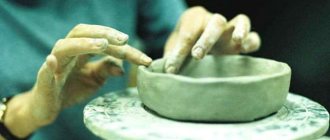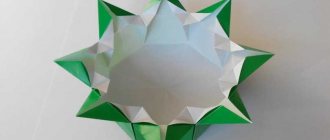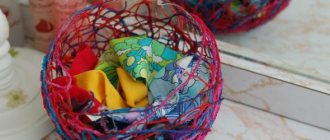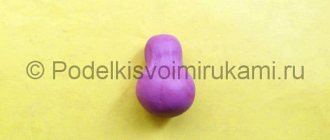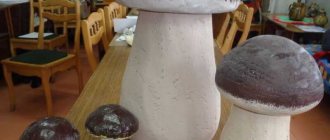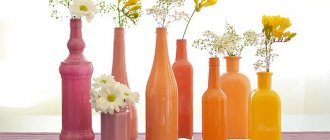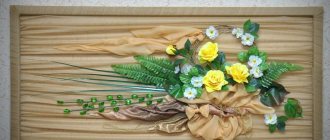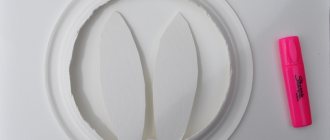From the bottle
To make a vase based on a bottle, you can even use ordinary rope thread. They wrap the product in a circle, trying to lay the thread as tightly as possible to the glued base of the bottle. Special glue must be applied, and there should not be a lot of it, as this may affect the appearance (the glue should not bleed through the thread).
This product can be used for decorative artificial flowers.
If you want to be creative, you can decorate the product even with ordinary buttons or the same thread, having previously dyed it in a contrasting color so that it contrasts with the background of the main material.
What can topiary be made from?
One of the advantages of this type of decorative products is that they can be created from a variety of materials.
So, you can make a tree with your own hands from:
- paper and fabric tapes;
- fabrics and lace;
- threads and ropes, sisal;
- beads;
- cones, chestnuts and acorns;
- nuts;
- paper;
- artificial flowers and leaves;
- napkins;
- newspapers;
- pasta;
- shells;
- caramel sweets;
- balloons (not inflated);
- packaging mesh for a bouquet of flowers.
And if you want to make a money tree with your own hands, then the crown will need to be decorated with artificial (or even real) bills or coins.
As an example, we have chosen for you a topiary decorated with cute paper flowers and hearts.
Decoration technique for a vase made of plaster “Old Stone”
Let's try to master the “old stone” technique.
- Wear rubber gloves.
- Spread bitumen wax on the surface of the walls with a brush.
- We remove the remains with a napkin.
- Take baby powder and sprinkle it on the surface.
- Using a new dry brush, spread over the surface so that the talc gets into each cavity.
- Melt the candles.
- Apply it to the surface of the vase with a brush.
- Let dry and polish with a soft cloth.
The talc in the wax will age the surface, so you get an amazing piece of furniture that can be displayed in a prominent place.
Sculptural and decorative items, various vases and other beautiful things can be made from plaster. This material is very easy to work with, takes on different shapes and is painted without problems. This building material has been used by people for a very long time. How to make a vase from plaster? Simple enough. In general, making products from plaster is very exciting. Moreover, gypsum as a material is absolutely safe.
To create decorative products you need a lot of imagination and imagination. But first, you need to understand how to make your fantasy come true. This technique can be learned by molding the bodies of plaster vases. A do-it-yourself plaster vase is made as follows: a sheet of aluminum foil is placed between polyethylene sheets.
All this must be placed on matter, which is folded in several layers. Using a sharp object, squeeze out a pattern on the foil. The foil with polyethylene must be rolled into a roll and the joint must be glued with tape. This roll should be fixed on a sheet of cardboard. At the base, around the roll, you need to make a thick and durable plasticine roller.
Next, prepare a gypsum solution. Add gypsum powder (350g) to water (120ml). You should wait a minute and mix thoroughly. The result is a creamy thick mass. Afterwards, the infusion must stand so that the air comes out of it. This solution is carefully and slowly poured onto the bottom of the mold in a three-centimeter layer. And leave it to dry for half an hour.
A jar or glass is placed on the resulting foundation, the diameter of which should be no more than 6 centimeters. This glass will be the inside of the vase. The glass should be exactly in the center. Several pebbles or another heavy object are placed inside it. This is ballast. The gypsum solution is poured into the space between the glass and the outer wall using a funnel.
The solution should not get inside. To do this, you can fill a glass with paper. To release air bubbles from the solution, the structure must be slightly shaken. In half an hour the vase will be ready. All that remains is to free it from the outer shell. In order to decorate a vase, you should first sand its edges with fine sandpaper. And then you can use all your imagination to decorate it.
Sometimes tin cans are used instead of glasses. You can simply wrap it in old knitted fabric or thick crumpled paper. This material is attached to a can and several layers of gypsum mortar are applied to it. It is better to use decorative plaster, but construction plaster is also suitable. You can put both dried and fresh flowers in such vases. After all, their base perfectly holds liquid for flowers.
Unique interior decorations, created with your own hands and to your own taste, are always valued more than any, even the most expensive, purchased products. Plaster stucco molding is a huge field for creativity. Many people think that only professionals using special equipment can work with plaster, but this is far from the case. A master class on creating a beautiful vase from plaster quickly and easily with your own hands will help even beginners without any special knowledge and skills to start working in this technique.
This is not a difficult and exciting activity, the main thing here is desire and accuracy. In the future, you will be able to create beautiful products of any complexity.
Step-by-step instruction
So, carefully follow our step-by-step instructions and as a result you will get a beautiful beaded tree trunk.
Step 1: mix the plaster
We line the container in which we will place the gypsum solution with cling film. Mix it as indicated on the package and pour it into a container with cling film.
Step 2: place the wood in the solution
Before it hardens, place the tree in the solution, drowning it as deeply as possible.
To prevent the tree from falling while the plaster hardens, it can be supported with a brick or large stone.
Step 3: cover the trunk with plaster
When the plaster has completely hardened, remove it from the container. Now the creative process begins where you give the trunk the shape and appearance of a real tree. To do this, it is necessary to completely cover the wire trunk of the tree with fresh gypsum solution. You can make several layers to give the product the desired shape.
Step 4: imitate the bark
When this layer dries, we take a knife in our hands and begin to form longitudinal stripes on the trunk, imitating the bark of a tree.
Step 5: Shape the Base
The gypsum base also undergoes changes - we give it the shape of a stone with roots. Since gypsum is a soft material, cutting out curly roots from it will not be difficult.
Step 6: paint the trunk
Lastly, apply gouache paint. Completely cover the finished trunk and roots using a damp sponge. It will lighten the edges and give the stone a natural, smooth transition from dark to light shades.
The finished product can be opened with any transparent varnish so that the paint does not peel off or get dirty. And in the end you will have an original tree that seems to grow from a large rock. A plaster stand will securely hold the tree and prevent it from falling. And a layer of gypsum on top of the wire base will give the branches and the trunk itself a natural look. We hope that thanks to this step-by-step master class, you now know how to make a tree trunk from beads.
We also suggest that you watch some good videos for a better understanding.
Floor vases made of plaster
Now you can start casting. With the help of such molds, floor vases are made from plaster with your own hands.
First, the halves of the form are connected and fixed by wrapping them with twine, adhesive tape, or electrical tape. The filling principle is similar to that described in the “Master Class” chapter.
The resulting craft is coated with paint, varnish, or a design is applied. If desired, leave the vase white.
Crafts from plaster for the New Year
On the eve of the upcoming holidays, various toys and decorations for the home and Christmas tree appear on store shelves.
And for those who are interested in creativity, it will not be difficult to make New Year’s candlesticks and lanterns, openwork snowflakes and stars with additional plaster decor.
Working with plaster is interesting, simple and exciting, it can be a complex and attention-consuming process of making stucco or holiday decorations.
Everyone will find interesting ideas in such needlework and will want to independently implement a project for making decor for their home or garden.
Master class on a do-it-yourself plaster vase to look like an old stone
This master class describes one of the simplest and most understandable techniques for making a vase, and the result will be gorgeous! To make a vase you will need:
- Two packages of plasticine (color is not important, plain color will do)
- Two paraffin candles
- About 20 g of liquid soap
- Low bottle with medium neck
- Dry gypsum (500 – 1000g)
- Cling film or plastic bag
- Cotton fabric
- Any dried herbs with stems, ears of wheat or oats
- Baby powder
- Bituminous wax and brushes
Stages of making a vase from plaster: First, we roll out 5 layers of plasticine: 2 wider, 2 narrower and one oval for the bottom.
Lubricate one side of the plasticine blanks with soap and lay out dry plants. We press them in so that the outline is imprinted, forming a clear pattern.
We collect the blank into a vase with prints inside. The main thing is to pinch the edges well so that the plaster does not leak out later.
We wrap the bottle with cloth and 5–6 layers of cling film and place it in the center of the vase.
We dilute gypsum powder according to the instructions. Holding the bottle, pour it to the middle of the vase. When it begins to harden slightly, fill the remaining portion to the brim. The drying time of the gypsum is usually indicated on the packaging, but if it is not there, it is better to wait 3 hours before removing the bottle. After this, leave the vase for another 2 hours and remove the plasticine.
The vase is ready. Now you can decorate it.
- Wearing gloves, apply bitumen wax with a brush. Carefully remove the remains with a napkin.
- Sprinkle the surface with baby powder and spread it with another brush.
- Having melted the candles, apply paraffin with a brush.
- We wait until the vase dries and polish it with a soft cloth.
DIY artificial trees made from pistachios
You will need:
- pistachio shell
- wire
- plaster
- spray paint (gold color)
- pot
1.
Use a drill to make a small hole in each shell.
2.
Cut the wire 15–20 cm long and attach one shell to each piece. After this, you need to twist the wires and you will get blanks.
3.
Now, twisting the wires, connect several leaves together - you should get a branch.
4.
Make several branches and twist them together to form a tree trunk.
5.
Using FUM tape, wrap the trunk and branches. You can use rope or thread instead of FUM tape.
6.
Paint the tree.
7.
Let's prepare the base.
- Prepare a pot suitable for your tree.
— Fill the pot with plaster and insert the tree into it.
— Wait for the plaster to dry.
— Finish the pot with paint.
Continuation of the "banquet"
- We dilute the plaster according to the instructions for it.
- Fill halfway, holding the bottle.
- As soon as the solution begins to harden, add it to the brim.
- Hardening time - look at the plaster packaging, but if you don’t find it, don’t touch the mold for 3 hours.
- Take out the bottle and leave for another 2 hours.
- We remove the plasticine and get the finished product.
Carton boxes
When throwing away a juice box, few people think that it can be used to make an excellent vase or flower pot.
We will need:
- juice box;
- gypsum;
- brushes;
- a plastic cup or other container of the depth you want to create a hole in the vase;
- acrylic paints.
Cut the box so that you get a cardboard vase blank of the height you need. Dilute the gypsum to the consistency of thick sour cream and pour it into the box.
While the plaster is still wet, place the cup inside the box of plaster, creating a hole for the plants.
Leave the vase until completely dry. Then carefully remove the box and take out the glass. Sand the surfaces with sandpaper. The vase is almost ready, all that remains is to decorate it.
We chose the method of applying paint with a lace stencil. To do this, we took lace ribbons and secured them to a plaster blank.
Spray paint the entire surface of the vase, you can also cover the inside. Let the paint dry completely and remove the lace ribbons.
This vase can be used as a pot for succulents or, if you have made a deep hole, you can put flowers in it.
Another option
This master class is a little more complicated, but nevertheless it is very interesting to make such a vase, and it will look simply gorgeous in the interior!
For work we will need:
- gypsum;
- plasticine;
- twine;
- form for filling (you can use a baking form of a suitable shape and size);
- shells (you can use any small parts).
Related article: Do-it-yourself laser burning on skin at home with video
Cover the filling mold with baking paper. We roll the plasticine into a sausage and roll it out to the size of the mold and, accordingly, the future walls of the vase. We dilute the gypsum to a thick sour cream.
We make imprints of shells on plasticine, then place it in a mold. Fill it with plaster to a depth of 3-4 cm. In total, you will need 5 walls for the vase (you can make it triangular or rectangular).
Until the plaster has completely hardened, after about 10-15 minutes it must be carefully removed from the mold. Leave the finished future walls of the vase until completely dry.
When the tiles are dry, you need to drill holes on the sides. We connect the tiles and tie them tightly with twine.
We place the assembled structure vertically and fill the bottom with plaster. After 15-20 minutes, remove the walls, level the bottom to the shape of the vase, and leave until completely dry. We drill holes in it to connect to the walls.
Now you need to paint all the parts. You can use acrylic paints of any color. Or you can use improvised means. For example, the color of a vase like in the photo can be obtained by mixing shoe polish with vegetable oil.
Then we coat all the parts with varnish and tie them together with twine.
Of course, you don’t need to pour water into such a vase, but you can put a small glass or plastic container in it so that you can put fresh bouquets in the vase.
Thus, making vases from plaster is quite easy; even a child can do it. Of course, under adult supervision. The main thing is to show imagination and the desire to get an original vase.
Vase decorating ideas
The decoration of the finished product is of particular importance. This is what can make a vase unique and inimitable. A wide variety of objects can be used as decorative materials.
Dry branches and wood cuts
They can be attached to the container using glue, double-sided tape, and then tied with a beautiful ribbon or lace.
Shells
It’s easy to decorate a vase made of any material with shells, but they look especially interesting on plaster.
Leg-split
This is one of the fastest and easiest ways to decorate a jar, bottle or cardboard tube.
Buttons and beads
They look interesting in any form: natural or when only their texture is visible, for example, from under plaster.
Spray dyes and glitter
A vase with this coating is made very quickly and is perfect for festive events.
There are decoupage napkins in a variety of themes, so you can create a vase in any style. For example, like this kitchen decoration, which can be used not only for flowers, but also for fresh garden herbs.
Cardboard, corrugated or crepe paper
You can twist different parts from paper and then glue them to the vase. Or simply wrap the container in beautiful corrugated paper.
A bright, original vase will be a worthy decoration for any room, especially a child’s room.
Such stylish vases will become the “highlight” of any interior, bringing harmony and beauty to it. And making them yourself will not only save the family budget, but will also give you an excellent opportunity to show your imagination and turn creative ideas into reality.
Do you think that only professionals can work with such a fragile and quickly hardening material? You are deeply mistaken, because now you will see one way in which you can make plaster vases with your own hands in a short period of time. To do this, you will not need to purchase an expensive segment, but you will have to carefully carry out all stages of the work. The main thing is patience and a little skill.
And you will also have to visit last year’s field, where ears of wheat or oats grew. Do you think that there is nothing there after the snow? In vain! After the water recedes, you can find so many interesting things! Moreover, this variety of herbs will be needed to create an amazingly beautiful relief on a future piece of furniture.
Gypsum products for the garden
Do-it-yourself plaster crafts for a summer residence are a quick and budget-friendly way to decorate the area.
You can start with simple “mushrooms”, making a shape for the stem from a plastic bottle, and a shape for the cap from a deep disposable plate. Cut off the top of the bottle and pour plaster inside.
To increase stability, the leg can be reinforced by placing a wire in the middle. Fill the hat plate with the solution.
After hardening, carefully cut the plastic, take out the resulting plaster parts, trim them with sandpaper and paint them. For outdoor figures, acrylic paints are a good choice.
It’s also quite easy to make outdoor vases using existing pots, buckets and even boxes as forms.
- If you want to diversify your country landscape with animal figures, then gypsum is perfect here too. Make a frame using wire, bottles, cans, form the body parts with a thick plaster solution and leave for a couple of days. After the product has dried, you can begin decorating.
- In this way, you can make, for example, a bird, the base of which will be a canister, and the wire for the head, neck, wings and tail. In this case, part of the canister can be left inside the product and get an original garden planter.
- And with the help of ready-made brick or stone molds, plaster will be used to create durable tiles for interior decoration in Scandi style.
To increase moisture and wear resistance, the figures are coated with a transparent varnish based on polyurethane or silicone.
Plaster vases from scrap materials
Most often, when working with plaster, craftsmen use the casting method. In order to make a plaster vase with your own hands using this technique, you need to choose the desired shape. It is not necessary to prepare the mold specially. You can find something suitable among the materials at hand.
For work, use the main container of the required size. It can be a plastic or glass bottle, box, container, or tall beer glass.
It is also necessary to take care of the detail, thanks to which it will be possible to make a recess inside the vase. It can be of any shape. Only here the master needs to pay attention to its size: too large can lead to the fact that the walls of the vase will be too thin.
If a shaped mold with a narrow neck is used for casting, for example, a bottle, plastic or glass, then after the plaster hardens, it will not be so easy to remove the craft. The plastic can be cut and removed. And glass containers will have to be carefully split so as not to damage the hand-made plaster vase.
What's good about this method?
There is no need to wait long - the glue hardens very quickly (1) and after 15 minutes you can already paint the barrel. I used solvent-based paint in a glass bottle, this kind of paint is sold in construction stores and costs about 120 rubles.
With such paint, there is no need to open it with varnish, because the hardened hot glue (aka melted rod) has a very dense structure, therefore, as I already said, the paint is not absorbed (2). It is enough to cover the barrel with paint, maybe in two layers. And voila - the trunk is already shiny and, moreover, repels water.
After painting, you can decorate the product and.. done!!!
That's all the tricks!
I came across this method of forming a trunk on the Internet only once, and then without details. That's why this article was born. Sorry that there are no photos of the process itself.. I don’t have semi-finished products for clarity. But I think everything is clear. Truly a wonderful idea!
No title. Discussion on
Principles of a Natural Diet
1. Limit meat consumption . Reduce meat consumption to 1 time per day. This will reduce the level of toxins that poison the body.
2. Don't overeat . When eating, do not fill your stomach completely, that is, do not overeat (when you get up from the table, you should want to eat a little more). Remember, overeating is one of the causes of many diseases, especially the gastrointestinal tract.
3. Before lunch and before dinner, eat raw salads , in summer and autumn, from cucumbers, tomatoes, herbs; in spring and winter from carrots, beets, cabbage, apples, grated on a coarse grater. Add lemon juice or vegetable oil to the salad - 1 tbsp. spoon. The functioning of the stomach and intestines improves.
Master Class
The technique of casting a vase with a rectangular base is discussed in detail here.
To make it you will need a container: a milk or juice box, a container, a box, a box. It is important to choose the right size form. In this case, a plastic container is used to store cereals.
It is also worth taking care of the part for the recess. It is convenient to take a glass or glass bottle with a diameter smaller than the mold for pouring.
- The part to be removed is placed in a larger container. It is held in such a way that it does not touch the bottom of the mold.
- Plaster diluted with water is carefully poured into the void between the mold and the part to form a recess.
- Then you should wait a while for the plaster to harden slightly. During this period, the recess part is kept suspended.
- When the mass “sets”, the structure is left until completely hardened. Then the vase is removed and the uneven surfaces are sanded with fine sandpaper.
You can leave the vase white - it's very stylish. But if the master has a desire to paint a craft or make a drawing on it, then you should not resist him. The finished vase can be varnished.
DIY country crafts: what do you need for them?
For a large and flat plate you will need a large sheet. This could be a leaf of maple, burdock, water lily and other plants with huge leaves.
Auxiliary materials will be: oilcloth, a sheet of paper for the backing and sand. It is worth noting that the paper should be slightly larger than the selected plant.
The plate will be made of plaster to which acrylic paint has been added. It can be green, the color of a summer leaf. Or it will turn out to be painted in shades of autumn. Gypsum can be replaced with clay. Country crafts will still be durable. True, then they will need to be painted after production. But this won’t make the plate any worse.
Making a vase made using a box and plaster bandages
For this method you will need:
- Juice box or other container with regular shapes
- Plaster bandage
- Dry plaster
- Acrylic white paint or enamel
- Vessel for mixing the solution
- Cling film
- Paints and brush
We cut the box to the height of the future vase plus 1.5 cm. In the upper part we make cuts 1.5 cm deep, bend the edges, press them to the front side and wrap them with thread.
We place the box on cling film so as not to stain the surface with plaster.
Prepare a gypsum solution in a suitable container. You should get a mass of medium thickness.
We cut the bandages into strips of 40 cm and lower them into plaster.
Let's start sculpting. We wrap the prepared bandages on the walls of the box. We start working from the top, gradually moving down. Then we leave the vase so that it has time to dry.
Then we apply white acrylic paint and enamel.
After this, the base box must be removed. Now you can start decorating the vase.
You can paint the vase with colors of your choice or use various beads, buttons, scraps of fabric, shells and ribbons.
Cut off the neck and bottom of a liter plastic bottle.
We roll out a layer of plasticine and insert bottles into it.
Fill the bottle with plaster, but not to the full height. We wrap a bunch of wooden skewers with film and tape to make it look like in the photo:
Insert the bundle into the bottle, holding it for a couple of minutes if necessary.
When the plaster hardens, cut the film and tape and remove the skewers.
We take out the vase from plasticine. We cut and remove the plastic.
When the vase is completely dry, smooth the surface with sandpaper, cover with a layer of PVA glue and decorate the vase in any way to your liking.
Plaster vase
To make such a plaster vase, take:
- 2 liter plastic bottle;
- gypsum;
- gypsum putty;
- bandages.
When getting started, first cover the table surface (or other work surface on which you will make the vase) with cellophane or cling film. This should be done to make it easier to remove the plaster after finishing work.
We dilute the gypsum with water to the consistency of thick sour cream, wait until it sets a little. Then we lay out a circle - this will be the bottom of the vase. Place a bottle on top of this circle and begin applying plaster.
Note! You will have to work quite quickly, since gypsum tends to harden quickly.
Now we wrap the part of the bottle sealed with plaster with bandages and leave for 30 minutes so that the plaster dries. You need to cover it with plaster and bandages just above the middle so that later you can easily pull out the bottle.
Next, we dilute the plaster putty and apply it over the bandages. Then again a layer of bandages, and again a layer of putty. The lower part of the vase is ready. For the top one, you can take an additional form, for example, a plastic jar.
Related article: Bead embroidery patterns for various flags of the world
We form the upper part of the vase in the same way - a layer of bandage, putty, another layer of bandage and a layer of putty. To make the vase strong and stable, you can apply several more layers of putty on top, and after complete drying, sand it with sandpaper.
We send the gypsum blank to dry for a day in a warm place. To paint a plaster vase, you can use acrylic or varnish paints.

